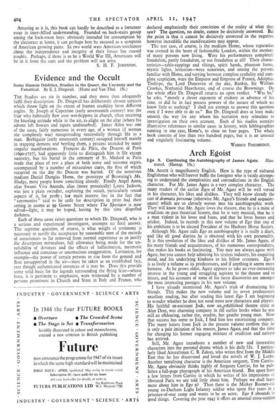Evidence and the Occult
Some Human Oddities, Studies in the Queer, the Uncanny and the Fanatical. By E. J. Dingwall. (Home and Van Thal. 15s.)
THE Studies are six in number, and they more than adequately fulfil their description. Dr. Dingwall has deliberately chosen subjects which throw light on the extent of human credulity from different angles. St. Joseph of Copertino (early seventeenth century) was the friar who habitually flew over worshippers in church, often retaining the kneeling attitude while in the air, to alight on the altar (where his advent left flowers and tapers undisturbed). James Allen was one of the cases, fairly numerous in every age, of a woman (if woman she completely was) masquerading successfully through life as a man. Berbiguier (early nineteenth century) occupied himself mainly in trapping demons and bottling them, a process attended by many singular manifestations. Francois de Paris, the Deacon of Paris (1690-1727), had apparently little to distinguish him in life except austerity, but his burial in the cemetery of St. Medard at Paris made that place of rest a place of both noisy and noisome orgies, accompanied by a number of miraculous cures, the first of which occurred on the day the Deacon was buried. Of the notorious medium Daniel Dunglas Home, the prototype of Browning's Mr. Sludge most people know something already. Finally Angel Anna, alias Swami Viva Ananda, alias (more prosaically) Laura Jackson, was just a plain swindler, exploiting the occult, particularly sexual aspects of it, for profit her main interest lies in the fact that "ceremonies" said to be unfit for description in print had their setting in rooms at 99 Gower Street where The Spectator is now edited—light, it may be hoped, having by this time dispelled darkness.
Each of these cases raises questions to which Dr. Dingwall, who is a serious and experienced investigator, attempts no final answer. The supreme question, of course, is what weight of testimony is necessary to justify the acceptance by reasonable men of the records of occurrences so far removed from normal experience as to justify the description miraculous, full allowance being made for the un- reliability of devotees and the effects of hallucination, mesmeric influence and conscious or unconscious exaggeration. Levitation, for example—the power of certain persons to rise from the ground and float unsupported in the air—must be taken as an established fact, rare though authenticated instances of it may be. Does this provide some solid basis for the legends surrounding the flying friar—whose feats, it is pertinent to emphasise, were witnessed by a number of persons prominent in Church and State in Italy and France, who declared emphatically their conviction of the reality of what they saw? The question, no doubt, cannot be decisively answered. But the point is that it cannot be decisively answered in the negative, however incredible the manifestations may appear.
The test case, of course, is the medium Home, whose reputation was created in the heart of fashionable London, within the memory of many persons now living. Were his performances completely fraudulent, partly fraudulent, or not fraudulent at all? Their charac- teristics—table-rappings and tiltings, spirit hands, phantom forms, mystic lights, levitation—were notorious, and among the persons familiar with Home, and varying between complete credulity and com- plete scepticism, were the Emperor and Empress of France, Adolphus Trollope, the Lord Dunraven of the day, Ruskin, Sir William Crookes, Nathaniel Hawthorne, and of course the Brownings. On the whole affair Dr. Dingwall returns an open verdict. "Was he," he asks, "merely a clever exponent of trickery in advance of his time, or did he in fact possess powers of the nature of which we know little or nothing? I shall not attempt to answer this question even if I were able to do so." But Dr. Dingwall does at least make smooth the way for any whom his narration may stimulate to investigation on their own account. Each of his studies contains illustrative references to similar cases in history, with bibliographies running in one case, Home's, to close on four pages. The whole book consists of less than two hundred pages, but it is an unusual and singularly fascinating volume.
WARREN POSTBRIDGE.


































 Previous page
Previous page